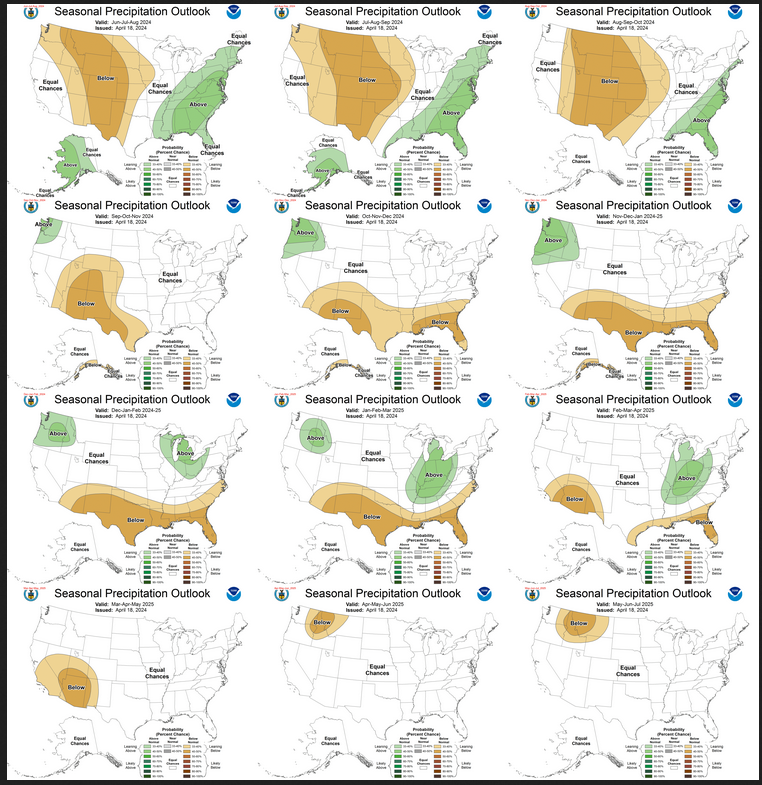On the third Thursday of the month right on schedule NOAA issued their updated Seasonal Outlook which I describe as their Four-Season Outlook because it extends a bit more than one year into the future. The information released also included the Mid-Month Outlook for the following month plus the weather and drought outlook for the next three months. I present the information issued by NOAA and try to add context to it. It is quite a challenge for NOAA to address the subsequent month, the subsequent three-month period as well as the twelve successive three-month periods for a year or a bit more.
With respect to the long-term part of the Outlook which I call the Four-Season Outlook, there is a rapid transition from El Nino to ENSO Neutral to LaNina. So getting the timing right is challenging. We are for all practical purposes now in ENSO Neutral. La Nina is the likely scenario for this summer almost to the end of the forecast period. The Outlook beyond June has not been significantly changed from what was issued last month. This suggests increasing confidence in the outlook. The forecast is a canonical La Nina plus trends.
First, Let’s Take a Look at the (mid-month) Outlook for June
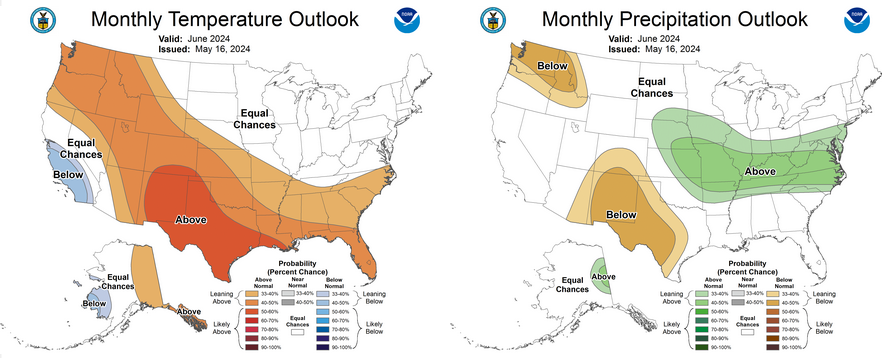
It will be updated on the last day of May.

The top row is what is now called the Mid-Month Outlook for next month which will be updated at the end of this month. There is a temperature map and a precipitation map. The second row is a three-month outlook that includes next month. I think the outlook maps are self-explanatory. What is important to remember is that they show deviations from the current definition of normal which is the period 1991 through 2020. So this is not a forecast of the absolute value of temperature or precipitation but the change from what is defined as normal or to use the technical term “climatology”.
| Notice that the Outlook for next month and the three-month Outlook are somewhat different, especially about precipitation. This tells us that July and August will be different than June to some extent. |
The full NOAA Seasonal Outlook extends through June/July/August of 2025 (yes that is more than a year out). All of these maps are in the body of the article. Large maps are provided for June and the three-month period June/July/August. Small maps are provided beyond that through June/July/August of 2025 with a link to get larger versions of these maps.
NOAA provides a discussion to support the maps. It is included in the body of this article. In some cases, one will need to click on “read more” to read the full article. For those on my email list where I have sent the url of the article, that will not be necessary.
Here are larger versions of the Temperature and Precipitation Outlook maps for next month.

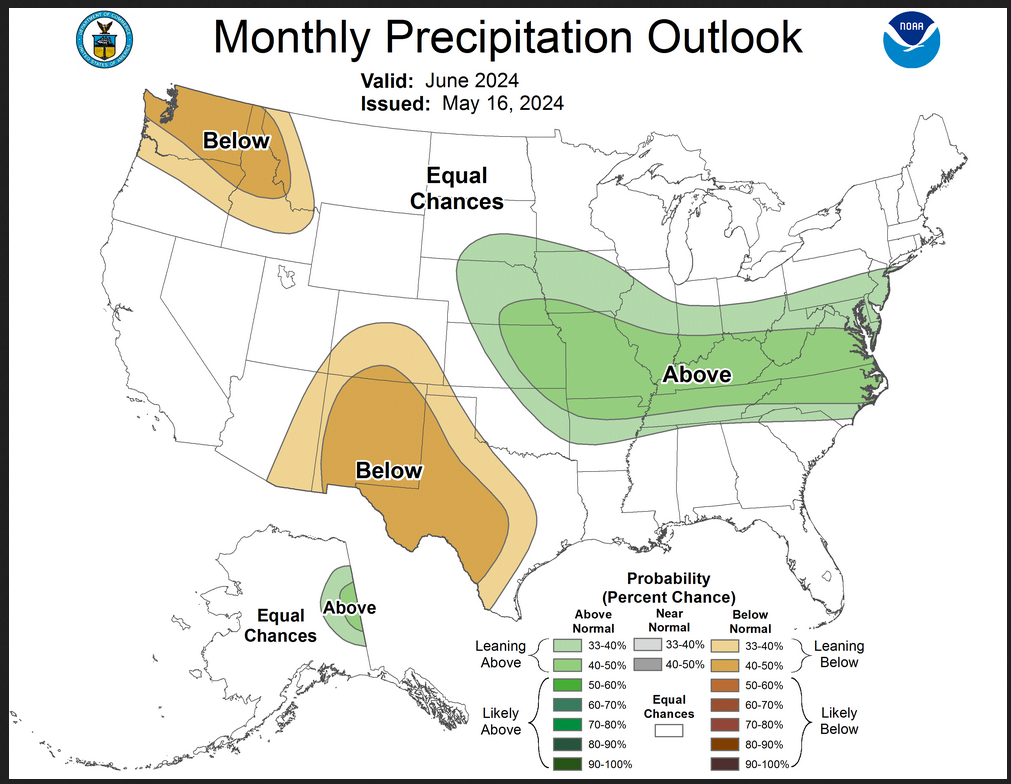
The maps are pretty clear in terms of the outlook.
And here are large versions of the three-month JJA 2024 Outlook
First temperature followed by precipitation.
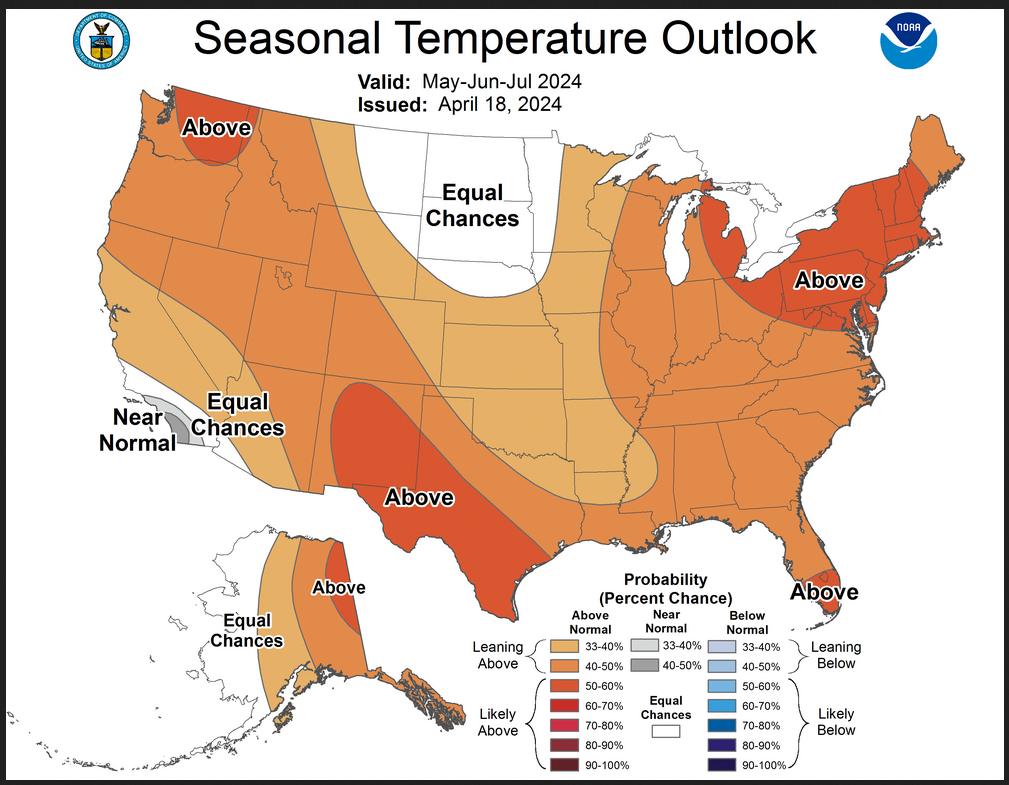

| These maps are larger versions of what was shown earlier. This is a pretty definitive pattern. |
Drought Outlook

| The yellow is the bad news and there is a lot of it. And there is a large area where drought is expected to persist. To the east, there is a small amount of area where drought improves or is eliminated. Overall the level of drought is expected to increase significantly And with a subpar Monsoon and a La Nina winter ahead, it is likely to go higher. |
Short CPC Drought Discussion
Latest Seasonal Assessment – Since the May-July Seasonal Drought Outlook (SDO) released in mid-April, marked improvements to drought conditions have occurred across central parts of the contiguous U.S. (CONUS) and parts of the Southwest. However, several locations did miss out on meaningful precipitation, especially across western portions of the Central Plains, where moderate to severe drought developed in parts of southeastern Colorado, central and western Kansas, and southwestern Texas. Pockets of abnormally dry and moderate drought conditions have also developed and/or expanded across parts of the Mid-Atlantic, the Florida Peninsula, Northern High Plains, and the Pacific Northwest. Nonetheless, soil moisture conditions are predominantly in decent shape across much of the CONUS as we head into the warmest months of the year.
Looking forward to the June-July-August (JJA) SDO, drought removal is forecast from the Central Plains eastward to the Eastern Seaboard, with favorable precipitation outlooks and neutral El Niño Southern Oscillation (ENSO) conditions likely through most of the season. Drought improvement and removal are also favored across portions of the Northern Plains and Upper Midwest, due in large part to it being climatologically the wettest time of year. For the western Great Plains and Intermountain West, widespread drought persistence is likely, with above normal soil moisture and predominantly near to above normal snowpack at the onset of the JJA period offset by warm and dry conditions being favored overall during the season. Drought development is forecast across portions of the southwestern CONUS, Pacific Northwest, and Northern Rockies, where soil moisture conditions, especially near the surface, are trending drier leading up to the onset of the forecast period. Uncertainty remains greatest across portions of the Southwest, given the historical onset of the North American Monsoon (NAM) in late-June and into July. However, given the sporadic nature of thunderstorm activity during the NAM season, areas not seeing precipitation will likely experience degrading or expanding drought conditions.
Drought development is forecast in the southeastern Alaska Panhandle, due to antecedent dryness, below normal snowpack, and unfavorable temperature outlooks for June and JJA. In Hawaii, drought persistence and development are likely, given the antecedent dryness, JJA being a very dry time of year, and the potential for ENSO to transition toward La Niña conditions (i.e. colder than normal sea surface temperatures in the central tropical Pacific) toward the end of August. Conversely, antecedent wet conditions, very wet precipitation outlooks for June and JJA, and the potential for tropical activity are likely to keep Puerto Rico and the U.S. Virgin Islands (USVI) drought-free through the end of August.
Looking out Four Seasons.
Twelve Temperature Maps. These are overlapping three-month maps (larger versions of these and other maps can be accessed HERE)

Notice that this presentation starts with July/Aug/Sep (JAS) since JJA is considered the near-term and is covered earlier in the presentation. The changes over time are generally discussed in the discussion but you can see the changes easier in the maps.
Comparing the new outlook with the prior Outlook,
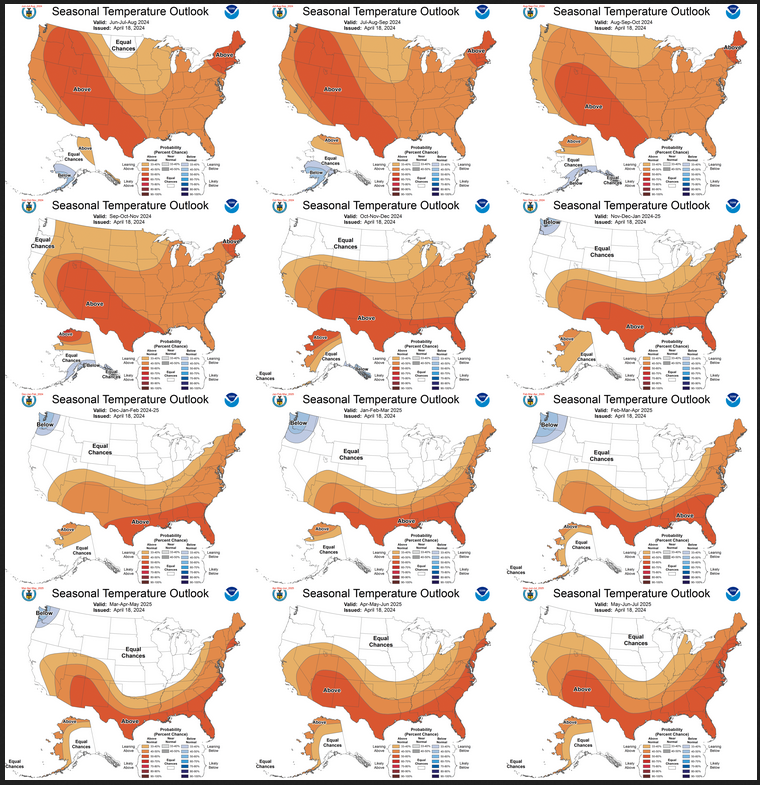
The easiest way to do the comparison is to print out both maps. If you have a color printer that is great but not needed. What I do is number the images from last month 1 – 12 starting with “1” and going left to right and then dropping down one row. Then for the new set of images, I number them 2 – 13. That is because one image from last month in the upper left is now discarded and a new image on the lower right is added. Once you get used to it, it is not difficult. In theory, the changes are discussed in the NOAA discussion but I usually find more changes. It is not necessarily important. I try to identify the changes but believe it would make this article overly long to enumerate them. The information is here for anyone who wishes to examine the changes. I comment below on some of the changes from the prior report by NOAA and important changes over time in the pattern.
| There has not been much of a change since last month. |
Now the Twelve New Precipitation Maps

Similar to Temperature in terms of the organization of the twelve overlapping three-month outlooks.
Comparing the new outlook with the prior Outlook,
The maps that were released last month.
A good approach for doing this comparison is provided with the temperature discussion.
| The overall outlook is the same as last month. |
NOAA Discussion
Maps tell a story but to really understand what is going you need to read the discussion. I combine the 30-day discussion with the long-term discussion and rearrange it a bit and add a few additional titles (where they are not all caps the titles are my additions). Readers may also wish to take a look at the article we published last week on the NOAA ENSO forecast. That can be accessed HERE.
I will use bold type to highlight some especially important things. All section headings are in bold type; my comments, if any, are enclosed in brackets [ ].
CURRENT ATMOSPHERIC AND OCEANIC CONDITIONS
Although the current interannual climate state is El Niño, as represented by the most recent seasonal mean Niño 3.4 index value of +1.1 degrees Celsius [Auther’s note: Silly it does not apply], the most recent weekly mean sea surface temperature (SST) anomaly for the Niño 3.4 region is only +0.3 C, as the equatorial Pacific is cooling. A substantial reservoir of colder than average ocean temperatures remains below the surface near the Date Line at a depth of 100 to 200 meters extending into the Eastern Pacific at a depth of about 150 meters to the surface. Negative SST anomalies are observed near the equator in the east-central Pacific with anomalies exceeding -1.0 degrees C in some locations. Outgoing longwave radiation (OLR) anomalies are weak across the tropical Pacific indicating near average convection and precipitation. Low-level (850-hPa) winds were near average over most of the tropical Pacific Ocean. Cross equatorial upper-level (200-hPa) wind anomalies were observed near the Date Line and over east-central equatorial Pacific. Most recent, short term, atmospheric and oceanic anomalies are more indicative of ENSO neutral conditions than the current El Niño interannual state.
Significant increases in soil moisture were observed in the last four weeks over the north-central CONUS, and positive soil moisture anomalies are observed over much of the region. Positive SST anomalies are currently observed along the Gulf Coast and near the Atlantic Coast of the Southeast. SST anomalies are near average along most of the West Coast. Negative SST anomalies are observed along the west coast of Mainland Alaska. Surface boundary conditions, such as soil moisture anomalies, and near coastal SST anomalies can influence local temperature and precipitation over the next season. Soil moisture anomalies have a greater influence on surface temperatures over the Great Plains in the summer months.
PROGNOSTIC DISCUSSION OF SST FORECASTS
SST forecasts from most North American Multi-Model Ensemble (NMME) dynamical models and from most statistical models, including the CPC Constructed Analog (CA) and Canonical Correlation Analysis (CCA) predict increasingly negative average SST anomalies for the Niño 3.4 region through the coming seasons into next winter. Some individual models of the NMME and of the International Multi-Model Ensemble (IMME or C3S) favor ENSO neutral SSTs in the Niño 3.4 region through autumn, while the consolidated NMME models indicates approximately a -1.1 degree C anomaly, considered to be a moderate La Niña event. The CPC Niño 3.4 SST consolidation forecast predicts a peak anomaly of -1.1 degrees C for the November-December-January (NDJ) season. The CPC ENSO Outlook predicts greater than an 80 percent chance of La Niña forming by meteorological boreal autumn, September-October-November (SON), and continuing through winter into early 2025.
30-DAY OUTLOOK DISCUSSION FOR JUNE 2024
During the first half of May 2024, the transition from El Nino to ENSO neutral continues as shown by both oceanic and atmospheric indicators. A further transition to La Nina remains favored to occur sometime during the summer months. The MJO is currently not well organized. Although some model forecasts of the RMM index do indicate some improvement in the signal over the next couple of weeks, it seems potentially transient in nature with high uncertainty. Also, given the time within the seasonal cycle, there is low confidence in any reliable impacts to the U.S. and so the MJO did not play any substantial role in the monthly outlook. Soil moisture anomalies, coastal sea surface temperatures (SSTs) and long-term temperature trends are considered in preparation of the June 2024 outlook.
Temperature
The June 2024 temperature outlook depicts elevated odds for above-normal monthly mean temperatures for a region from eastern mainland Alaska to the Pacific Northwest and northern Rockies south and east to the Southwest CONUS and eastward to include the southern Plains and Southeast. Subseasonal model guidance (ECMWF, GEFS, among others) favors mean ridging for the west-central CONUS northward across western Canada to eastern Alaska in early June. The potential ridging elevates odds for warmer than normal conditions for the first third of June for much of this area with dry soil moisture conditions adding support for areas in the Pacific Northwest, northern Rockies and parts of the Southwest and southern High Plains. The majority of the NMME and C3S monthly model predictions also indicate above-normal temperatures for this region. Subtropical ridging along the southern tier of the U.S. supports elevated odds for above-normal temperatures for the southern Plains, Gulf coast and Southeast. Highest odds are forecast for the eastern Southwest and Texas where ridging, dry surface conditions and positive long-term temperature trends co-exist.
Below-normal monthly mean temperatures are favored for two small areas for coastal central and southern California and also for parts of southwest Alaska. Cooler than normal ocean surface temperatures contribute to these forecasts with favored mean forecast troughing near and along the southern half of the West coast also supporting below-normal temperatures for the California region.
A dipole forecast for enhanced odds for below-normal (above-normal) temperatures was considered for parts of the Midwest, Ohio Valley and mid-Atlantic (northern Great lakes and New England) respectively. Conflicting model forecast guidance, soil moisture conditions and long-term temperature trends, however, made highlighting these areas in the outlook a low confidence forecast at the current time. Therefore, Equal Chances (EC) for either above-, near- or below-normal temperatures is forecast for the mid-month outlook and [Editor’s Note: will be] reevaluated for the end of the month update.
Precipitation
For precipitation, elevated odds for above-normal monthly total precipitation amounts are forecast for a region from the central Plains eastward across the Ohio Valley to the mid-Atlantic. Both subseasonal and monthly model predictions indicate the tendency for a mean frontal zone in the interior of the CONUS from the Atlantic seaboard westward to the central CONUS. The location of this wetter than normal area is quite variable amongst the model solutions so the forecast area is generally placed in the most likely region after considering all the available information.
Drier than normal monthly precipitation amounts are forecast for eastern areas of the Southwest as well as parts of the Pacific Northwest and northern Rockies. NMME and C3S model monthly predictions are in very good agreement this month similar to last several monthly forecast cycles for below-normal precipitation for the eastern Southwest, south-central Rockies and much of Texas implying a later and/or weaker southwest monsoon onset. Subseasonal model guidance in early June indicates positive 500-hPa height anomalies in the northeast Pacific ocean implying a northward shifted storm track and so elevated odds for below-normal precipitation is forecast in the Pacific Northwest and northern Rockies. Some NMME and C3S model guidance also supports this forecast.
Favored forecast ridging in western Canada can sometimes enhance warm season precipitation for far east-central mainland Alaska so a slight tilt toward above-normal precipitation is highlighted in this area for June 2024.
Remaining areas depicted in white are forecasts of EC for either above-, near- or below-normal precipitation amounts due to weak climate signals and/or low historical forecast skill or reliability.
SUMMARY OF THE OUTLOOK FOR NON-TECHNICAL USERS (Focus on June, July and August)
At present, an El Niño Advisory remains in effect but atmospheric and oceanic patterns associated with El Niño are decreasing. El Niño Southern Oscillation (ENSO) neutral conditions are expected for the April-May-June (AMJ) season as a whole [Editor’s note: Dan Collins is making the point that officially we are still in El Nino but the atmosphere is not responding so we have weather that is more like ENSO Neutral], and there are approximately even chances of ENSO neutral or La Niña conditions by the June-July-August (JJA) season. A La Niña climate state is more likely to develop by July-August-September (JAS) with a probability of almost 70 percent, and would be expected to continue through winter, once in place.
Temperature
The JJA 2024 temperature outlook favors below-normal temperatures for the southwestern coast of Mainland Alaska, while above-normal temperatures are favored for central and eastern Alaska. Above-normal temperatures are likely for the western Contiguous U.S. (CONUS) and across the Southern Plains into the western Gulf Coast region. Above-normal temperatures are also favored for the eastern CONUS with probabilities for above-normal temperatures exceeding 50 percent for the Northeast. Equal Chances (EC) of below, near, and above-normal seasonal mean temperatures are indicated for parts of the northern central CONUS.
Precipitation
The JJA 2024 precipitation outlook slightly favors above-normal precipitation across most of Alaska. The outlook favors below-normal precipitation across most of the West from the Pacific Coast across the Rocky Mountains, while EC is predicted for the climatologically drier region over California, Nevada, and Arizona. Above-normal precipitation is favored for a large area of the eastern CONUS stretching from the Gulf Coast northeastward across the Lower Mississippi Valley and the Southeast, into the Ohio Valley, Mid-Atlantic, and southern New England. For the remaining areas of the central CONUS, where possible seasonal total precipitation amounts are predicted to be similar to climatological probabilities, EC is forecast.
BASIS AND SUMMARY OF THE CURRENT LONG-LEAD OUTLOOKS
PROGNOSTIC TOOLS USED FOR U.S. TEMPERATURE AND PRECIPITATION OUTLOOKS
The seasonal temperature and precipitation outlooks are based primarily on forecast tools derived from the NMME, including calibrated versions, such as the Probability Anomaly Correlation (PAC) and the Calibration, Bridging and Merging (CBaM), which calibrates the dynamical model forecast using Bayesian Joint Probability (BJP) models, as well as generating statistical or “bridging” BJP models of temperature and precipitation from dynamical model Niño 3.4 anomaly forecast predictors. An ENSO-OCN forecast tool is used to represent the combined influence of the El Niño Southern Oscillation (ENSO) and decadal timescale trends in temperature and precipitation, using the Optimum Climate Normal (OCN). La Niña impacts are considered in the outlooks from JJA 2024 through March-April-May (MAM) 2025, with La Niña impacts possible late in the JJA 2024 season despite equal chances of ENSO neutral or La Niña for the season as a whole. Longer lead outlooks, beginning in April-May-June (AMJ) 2025 are based primarily on decadal temperature and precipitation trends . A consolidation of multiple statistical and dynamical forecast tools that utilizes PAC calibration is used throughout the outlooks from JJA 2024 to JJA 2025.
PROGNOSTIC DISCUSSION OF OUTLOOKS – JJA 2024 TO JJA 2025
TEMPERATURE
The JJA 2024 seasonal temperature outlook favors below normal temperatures for the southwestern coast of Mainland Alaska and the Alaska Peninsula, supported by dynamical model forecasts from the NMME and below average SSTs near the coast. Above normal temperatures are favored for eastern Alaska as in most dynamical model forecasts and the consolidation. Above normal temperatures are likely for most of the western CONUS, with probabilities exceeding 60 percent for parts of the Southwest, supported by the consolidation, related to significant decadal trends in summer temperatures and reinforced by a below normal precipitation forecast. Probabilities favoring above normal temperatures are reduced for the California coast, where models predict potential below normal temperatures in June. Above normal temperatures are favored across the southern half of the Great Plains and for most of the eastern CONUS in the JJA 2024 seasonal outlook, in agreement with most forecast tools. EC is forecast for the northern central CONUS, where some models such as the CBaM indicate the potential for below normal temperatures, and positive soil moisture anomalies may help maintain below or near normal temperatures, early in the season.
The temperature outlooks for the next two seasons, through summer into early autumn, favor above normal temperatures across the entire CONUS, driven by strong decadal temperature trends in these seasons, and lesser impacts of a potential La Niña. The temperature outlook for Alaska during this period favors below normal temperatures for parts of southern Alaska and above normal temperatures for northern Alaska, influenced by La Niña and decadal trends, respectively. This temperature pattern essentially continues in the outlooks for Alaska into early spring of 2025, as La Niña is predicted to continue, after which, above normal temperatures are increasingly favored for Alaska at longer leads, related to decadal trends . A more canonical La Niña temperature pattern is favored over the CONUS from late autumn through winter, with below normal temperatures favored for parts of the Pacific Northwest from NDJ 2024-2025 through MAM 2025, and above normal temperatures more likely across the southern tier of the CONUS, including most of the Southwest, the Gulf Coast, and the Eastern Seaboard. Decadal temperature trends favor above normal temperatures across most of the CONUS for the longer leads, excluding parts of the northern central CONUS, where trends are weaker.
PRECIPITATION
The JJA and JAS seasonal precipitation outlooks favor above normal precipitation for most of Alaska, excluding the western Aleutians and Southeast Alaska, with dynamical models predicting southerly flow into the state. Below normal precipitation is favored for most of the western CONUS, excluding only climatological drier regions of California, Nevada and Arizona, supported by most tools and the consolidation, and consistent with potential early impacts of La Niña in some areas. Above normal precipitation is favored from the Gulf Coast region across the Lower Mississippi Valley, the Ohio Valley, Mid-Atlantic, and southern New England, consistent overall with the precipitation consolidation, decadal trends , and potential early tropical activity related to La Niña and above average tropical SSTs.
The next several seasonal precipitation outlooks indicate an evolution of the precipitation pattern over the CONUS, shifting areas of favored below normal precipitation southward away from the northern tier and west coast, and eastward towards the Mississippi Valley. Above normal precipitation is favored over the Northwest by the September-October-November (SON) season into winter, consistent with a predicted La Niña. During the winter season, areas of favored above normal precipitation shift eastward into the Northern Plains and southeastward into the central Mississippi and Ohio Valleys. Winter into early spring seasonal outlooks favor below normal precipitation across much of the southern tier of the CONUS from Southern California and the Southwest to the Gulf Coast and Southeast and for the south coast of Alaska, following a canonical La Niña precipitation pattern, as represented by regressions of precipitation onto Niño 3.4 SST anomalies. The last three precipitation outlooks favor below normal precipitation for parts of the northwestern CONUS, due to decadal trends favoring drier conditions. Beginning in October-November-December (OND) 2024 through all longer leads, above normal precipitation is favored for parts of the North Slope of Alaska, due to positive decadal trends in precipitation and adjacent SSTs.
The key piece of information used by NOAA follows.

| It looks like ENSO is Neutral now and by summer we should be in La Nina which continues through the forecast period shown here but the full forecast in this article goes beyond next winter. This type of graphic does not show how strong an El Nino or a La Nina is likely to be. What is forecast is a La Nina that is stronger than a marginal La Nina but not very strong. |
Resources
Other Reports and Information

| This is not a forecast but the current smoke situation. There is smoke from local fires and a lot of light smoke coming from Canada. |
USDA can be accessed HERE.
FIRE Report can be accessed HERE
–
| I hope you found this article interesting and useful. |
–

